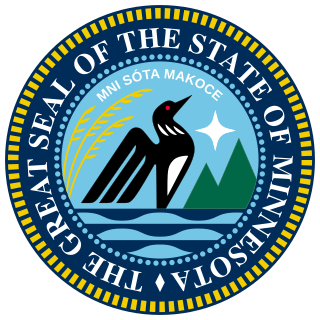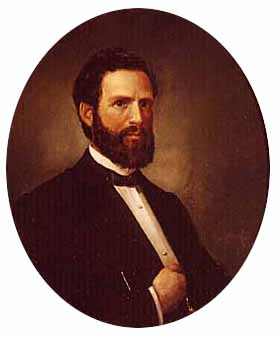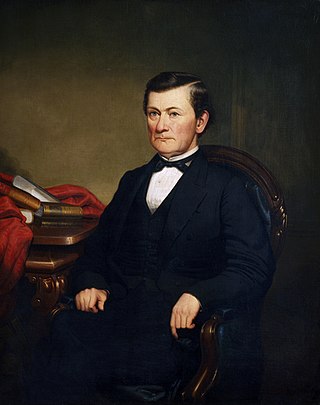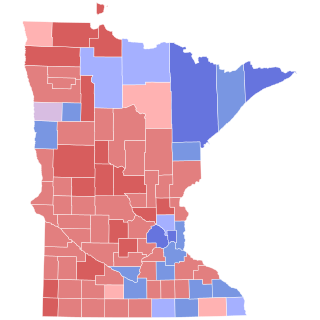| |||||||||||||||||
| |||||||||||||||||
 County Results:
| |||||||||||||||||
| |||||||||||||||||
The 1869 Minnesota gubernatorial election was held on November 2, 1869, to elect the governor of Minnesota.
| |||||||||||||||||
| |||||||||||||||||
 County Results:
| |||||||||||||||||
| |||||||||||||||||
| Elections in Minnesota |
|---|
 |
The 1869 Minnesota gubernatorial election was held on November 2, 1869, to elect the governor of Minnesota.
| Party | Candidate | Votes | % | |
|---|---|---|---|---|
| Republican | Horace Austin | 27,348 | 50.17 | |
| Democratic | George L. Otis | 25,401 | 46.60 | |
| Prohibition | Daniel Cobb | 1,764 | 3.24 | |
| Total votes | 54,513 | 100 | ||
| Republican hold | ||||

The governor of Minnesota is the head of government of the U.S. state of Minnesota, leading the state's executive branch. Forty people have been governor of Minnesota, though historically there were also three governors of Minnesota Territory. Alexander Ramsey, the first territorial governor, also served as state governor several years later. State governors are elected to office by popular vote, but territorial governors were appointed to the office by the United States president. The current governor of Minnesota is Tim Walz of the Democratic-Farmer-Labor Party (DFL), affiliated with the national Democratic Party.

The Minnesota House of Representatives is the lower house of the U.S. state of Minnesota's legislature. It operates in conjunction with the Minnesota Senate, the state's upper house, to craft and pass legislation, which is then subject to approval by the governor of Minnesota.

The 1868–69 United States Senate elections were held on various dates in various states. As these U.S. Senate elections were prior to the ratification of the Seventeenth Amendment in 1913, senators were chosen by state legislatures. Senators were elected over a wide range of time throughout 1868 and 1869, and a seat may have been filled months late or remained vacant due to legislative deadlock. In these elections, terms were up for the senators in Class 1.

Virginia's elections of 1869 occurred during the post-American Civil War Reconstruction Era and included African-American candidates and so-called "carpetbaggers", politicians from the North, often former Union Army officers, who ran in elections in southern states then under the authority of the Federal government and U.S. Army. The election included the 1869 Virginia gubernatorial election held on July 6, 1869, to elect the governor of Virginia. Gilbert Carlton Walker was elected as a "True Republican" defeating H. H. Wells, who was running as a "Radical Republican." Walker switched his party affiliation to Democratic in 1870.

The 1888 Minnesota gubernatorial election was held on November 6, 1888 to elect the governor of Minnesota.

The 1886 Minnesota gubernatorial election was held on November 2, 1886 to elect the governor of Minnesota.

The 1883 Minnesota gubernatorial election was held on November 6, 1883, to elect the governor of Minnesota.

The 1881 Minnesota gubernatorial election was held on November 8, 1881, to elect the governor of Minnesota.

The 1879 Minnesota gubernatorial election was held on November 4, 1879, to elect the governor of Minnesota. Incumbent John S. Pillsbury was reelected to a third term.

The 1877 Minnesota gubernatorial election was held on November 6, 1877 to elect the governor of Minnesota. Incumbent John S. Pillsbury was reelected to a second term.

The 1875 Minnesota gubernatorial election was held on November 2, 1875, to elect the governor of Minnesota.

The 1873 Minnesota gubernatorial election was held on November 4, 1873, to elect the governor of Minnesota.

The 1871 Minnesota gubernatorial election was held on November 7, 1871, to elect the governor of Minnesota. Incumbent Horace Austin was reelected to a second term.

George Lorenzo Otis was a lawyer and politician in the U.S. state of Minnesota. He served as the 14th mayor of Saint Paul, Minnesota, and also in both houses of the state legislature. Otis ran for Governor of Minnesota in 1869 as a Democrat, but lost to Republican Horace Austin, receiving 46.6% of the vote.

The 1867 Minnesota gubernatorial election was held on November 5, 1867, to elect the governor of Minnesota. Incumbent governor William Rainey Marshall was reelected to a second term.

The 1865 Minnesota gubernatorial election was held on November 7, 1865, to elect the governor of Minnesota.

The 1863 Minnesota gubernatorial election was held on July 10, 1863, to elect the governor of Minnesota.

The 1861 Minnesota gubernatorial election was held on November 5, 1861, to elect the governor of Minnesota. Incumbent Alexander Ramsey was reelected to a second term.

The 2018 Minnesota gubernatorial election took place on November 6, to elect the 41st Governor of Minnesota as incumbent Democratic (DFL) Governor Mark Dayton chose not to run for re-election for a third term. The Democratic nominee was U.S. Representative Tim Walz from Minnesota's 1st congressional district while the Republican Party nominated Hennepin County commissioner Jeff Johnson for a second consecutive time. The Independence Party of Minnesota did not field a candidate for the first time since 1994. Going into the election polls showed Walz ahead; the race was characterized as lean or likely DFL.

The eleventh Minnesota Legislature first convened on January 5, 1869. The 11 members of the Minnesota Senate who represented odd-numbered districts were chosen in the General Election of November 5, 1867, while the 11 members of the Minnesota Senate who represented even-numbered districts, and the 47 members of the Minnesota House of Representatives, were chosen in the General Election of November 3, 1868.